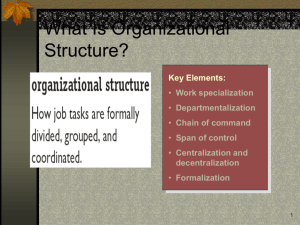Ch.10 Foundations of Organizational Design
advertisement
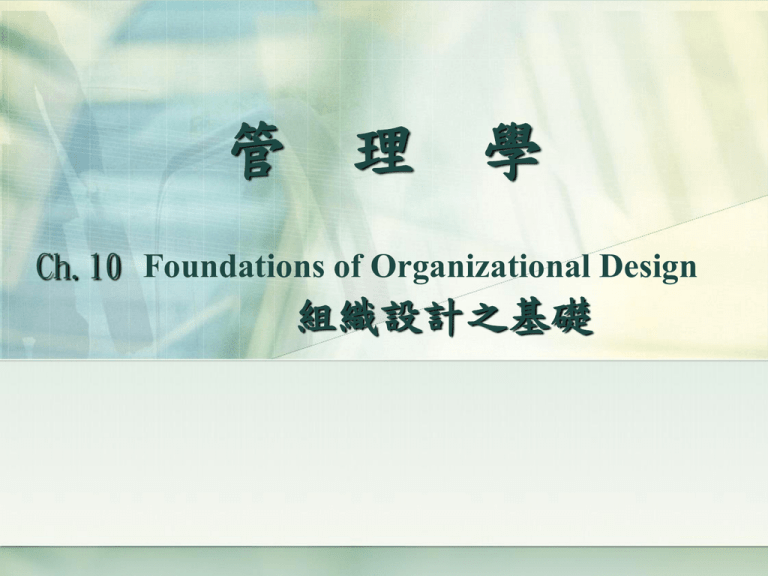
管 理 學 Ch.10 Foundations of Organizational Design 組織設計之基礎 • 蜈蚣走路需要 Align. • organization chart vs. organizing. • 組織的目的在於 讓平凡人做不平凡事。 (P. F. Drucker) • 不要期待主管給你溫暖,因為他站的位置比你高 ,比你更寒冷。 (104, Simon) 2 綱要 10.1 designing Organizational Structure: 六個決策要素 10.2 Mechanistic vs. Organic organizations: 機械與有機 10.3 Contingency factors affecting structural choice: 四 個權變變數 10.4 傳統組織設計:Tradition vs. Contemporary 3 Exhibit 10-1: Purposes of Organizing 10.1 Defining Organizational Structure Organizing arranging and structuring work to accomplish an organization’s goals. Organizational Structure the formal arrangement of jobs within an organization. Organizational Design a process involving decisions about six key elements: 5 設計組織結構: 六個決策要素 1. 工作專業化 2. 部門化 3. 指揮鏈 4. 管轄幅度 5. 集(分)權 6. 形式化 討論:1. 複雜度(分科、分層、差異化), 集權度,形式化。 2. one best way? 6 1. Work Specialization 工作專業化 The degree to which tasks in the organization are divided into separate jobs with each step completed by a different person. Overspecialization can result in human diseconomies from boredom, fatigue, stress, poor quality, increased absenteeism, and higher turnover 7 Exhibit 10-2: Economies and Diseconomies of Work Specialization 2. Departmentalization 部門化 Functional Grouping jobs by functions performed Process Product Grouping jobs by product line Geographical Grouping jobs on the basis of product or customer flow Customer Grouping jobs by type of customer and needs Grouping jobs on the basis of territory or geography 9 Functional Departmentalization: cost L, morale H, 隧道視線 Plant Manager Manager, Engineering Manager, Accounting Manager, Manager, Manager, Manufacturing Human Resources Purchasing 10 Product Departmentalization Bombardier, Ltd. Mass Transit Sector Recreational and Utility Vehicles Sector Mass Transit Division Recreational Products Division Bombardier-Rotax (Vienna) Logistic Equipment Division Rail Products Sector Industrial Equipment Division Bombadier-Rotax (Gunskirchen) 11 Geographical Departmentalization Vice President for Sales Sales Director, Western Region Sales Director, Southern Region Sales Director, Midwestern Region Sales Director, Eastern Region 12 Process Departmentalization Plant Superintendent Sawing Department Manager Planing and Milling Department Manager Finishing Department Manager Inspection and Shipping Department Manager Assembling Department Manager Lacquering and Sanding Department Manager 13 Customer Departmentalization e.g. 楷模廣告 Director of Sales Manager, Retail Accounts Manager, Wholesale Accounts Manager, Government Accounts 14 3. Chain of Command 指揮鏈 The continuous line of authority that extends from upper levels of an organization to the lowest levels of the organization and clarifies who reports to who. Unity of Command 指揮統一 The concept that a person should have one boss and should report only to that person. e.g. Enron. Whistling?(吹口哨,打小報告) 15 Authority 職權 The rights inherent in a managerial position to tell people what to do and to expect them to do it. Responsibility 職責 The obligation or expectation to perform. Line vs. Staff 16 Exhibit 10-4: Chain of Command and Line Authority 17 Exhibit 10-5: Line vs. Staff Authority 18 4. Span of Control 管轄幅度 The number of employees who can be effectively and efficiently supervised by a manager. affected by: Skills and abilities of the manager Employee characteristics Characteristics of the work being done Similarity of tasks Complexity of tasks Physical proximity of subordinates Standardization of tasks IS, Culture, Leading style,…… 19 Contrasting Spans of Control Organizational Level Members at Each Level 1 1 1 2 4 8 3 16 64 4 64 512 5 256 4,096 6 1,024 7 4,096 Span of 4 Operatives = 4,096 Managers (levels 1-6) = 1,365 Span of 8 Operatives = 4,096 Managers (levels 1-4) = 585 20 5. Centralization 集權 Decentralization 分權 Organizations in which decision-making is pushed down to the managers who are closest to the action. Employee Empowerment 賦權 The degree to which decision-making is concentrated at a single point in the organizations. Increasing the decision-making authority (power) of employees. Delegation 授權 21 Exhibit 10-7: Centralization or Decentralization 6. Formalization 形式化 The degree to which jobs within the organization are standardized and the extent to which employee behavior is guided by rules and procedures. Highly formalized jobs offer little discretion over what is to be done. e.g. Explicit job description. 討論:論文的實質內容與形式規格 23 10.2 Mechanistic vs. Organic Organization: Paradigm Shift (軍隊,C&C vs. 知識工作者,交響樂團) Mechanistic • High Specialization • Rigid Departmentalization • Clear Chain of Command • Narrow Spans of Control • Centralization • High Formalization Organic • Cross-Functional Teams • Cross-Hierarchical Teams • Free Flow of Information • Wide Spans of Control • Decentralization • Low Formalization 24 10.3 contingency factors 權變理論架構 vs. one best way 權變因素 組織結構 .策略 .複雜度 .規模 .集權度 .技術 .形式化 .環境 (權力,政治) 組織效能 .獲利,成長 .顧客滿意 .員工滿意 25 Contingency Factors: 1. Strategy: Structure follows Strategy (A. Chandler) Innovation 攻,Amazon, Starbucks Pursuing competitive advantage through meaningful and unique innovations favors an organic structuring. Cost minimization 守,McDonald Focusing on tightly controlling costs requires a mechanistic structure for the organization. Imitation Minimizing risks and maximizing profitability by copying market leaders requires both organic and mechanistic elements in the organization’s structure. 26 2. Size As an organization grows larger, its structure tends to change from organic to mechanistic with increased specialization, departmentalization, centralization, and rules and regulations. 27 實證研究 規模 + 複雜度 .水平差異化 .垂直差異化 政府機關 (企業組織) e.g. Parkinson’s law: The number of subordinates increases at a fixed rate regardless of the amount of work produced. 28 實證研究 規模 + 複雜度 .水平差異化 .垂直差異化 政府機關 (企業組織) e.g. Parkinson’s law: The number of subordinates increases at a fixed rate regardless of the amount of work produced. 29 實證研究 規模 - 集權度 專業管理者 (擁有者) 30 實證研究 + 形式化 規模 相依單位 (獨立單位) 31 3. Technology Organizations adapt their structures to their technology. Routine technology = mechanistic organizations Non-routine technology = organic organizations 32 Structural Characteristics Woodward’s Findings on Technology, Structure, and Effectiveness Unit Production Mass Production Low vertical differentiation Low horizontal differentiation Low formalization Moderate vertical High vertical differentiation differentiation High horizontal Low horizontal differentiation differentiation High formalization Low formalization Most effective structure Organic Mechanistic Process Production Organic 33 4. Environmental Uncertainty Mechanistic organizational structures tend to be most effective in stable and simple environments. The flexibility of organic organizational structures is better suited for dynamic and complex environments. 34 10.4 Traditional Designs 1. Simple structure 簡單結構 Low departmentalization, wide spans of control, centralized authority, little formalization 2. Functional structure 功能結構 Departmentalization by function: Operations, finance, human resources, and product research and development 3. Divisional structure 部門結構 Composed of separate business units or divisions with limited autonomy under the coordination and control the parent corporation. 討論: 1. 大潤發採購部品保組,遠航飛安室 2. 自主團隊 35 有多自主? Exhibit 10-10: Traditional Organizational Designs 作業 1. Case study: a manager’s dilemma (p. 292) (1) Identify and articulate business problems (2) Gather and analyze information applicable (3) Identify and apply an appropriate tool for solving problems. 2. Thinking critically about ethics (p. 309) (1) Identifies Dilemma. (2) Considers Stakeholders (3) Analyzes Alternatives and Consequences 37 3. Developing your delegating skill (p. 309) 4. Team exercise (p. 310)上網找三個組織之組織圖, 討論其優缺點,比較異同。 5. Internet-based exercise (p. 311): “政府再造?行政院 減肥?部會精簡!” 38 回顧 1. 比較 Organization chart VS. Organizing 2. 比較 Organizational structure VS. Design 3. 區分 Mechanistic VS. Organic organization 39 Terms to Know organizing organizational structure organizational chart organizational design work specialization departmentalization cross-functional teams chain of command authority responsibility unity of command span of control centralization decentralization employee empowerment formalization mechanistic organization organic organization unit production mass production process production simple structure functional structure divisional structure
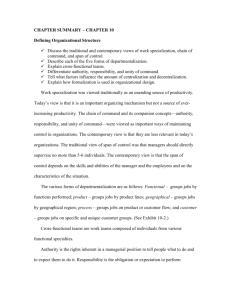



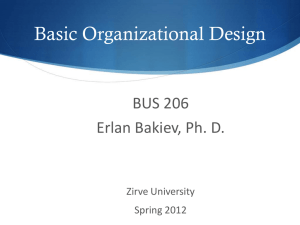
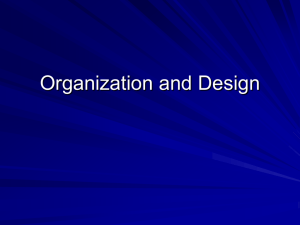
![[SUMMARY] Manajemen (Chapter 10)](http://s3.studylib.net/store/data/008743248_1-4e2b946756cf43cea567b50ee8fe6208-300x300.png)
